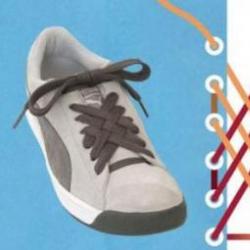Pattern of winter booties for baby with sizes. DIY baby booties made from fabric. We create booties from old jeans with our own hands
Booties made of felt, lined
2 parts are cut out from the main fabric (felt), and 2 parts from the lining fabric (calico).
First, an applique is sewn to the felt blank - we have a matryoshka doll.
The back parts are sewn together on all four top blanks (2 from felt, 2 from calico).
Next, the felt and lining parts are sewn together in pairs along the top part, from the inside out, 5 mm from the edge. You can sew the tape in the right places at the same time (you can sew it later on the finished booties). On the rounded places on the fabric, notches of 2-3 mm are made so that the parts turn out along a smooth line and do not pull together. Turn the pieces inside out, straighten and iron.
Two parts of the sole - felt and lining fabric - are folded together and basted. The upper part of the bootie is sewn to the sole with a simple stitch, the seam is obvious. The edges can be overcast, zigzag stitched or decoratively hemmed by hand.
Tip: the sole can be made in three layers if you also cut out a leather or suede part for the bottom.
Felt booties pattern:

Vologda lace Collar with placket Video tutorials for crochet flowers World catalog of ideas Pattern for a gingerbread house Pattern for a sleeve Pattern for a teddy dog Pattern for a sewing machine Pattern for a six-piece skirt Patterns Turban Patterns for a boho dress Vasilisa knitting booties Waldorf doll Pattern Felting a brooch from wool Felting a house Felting toys clothes Felting scarf Felted vest Knitted mittens Knitted hedgehog Cotton toys Classic waffles from the USSR miscellaneous
Minion girl minion made of fleece with a pattern candid photos of girls booties with a flower candid photos open loop crochet musical dolls pinkip Moomintroll knitting donkey Eeyore cartoons funny mini skirts pattern musical cards for Christmas musical cards for men booties berries musical cards for your beloved mini sandwiches savory snack sweet pepper crochet miniskirt miniature embroidery octopus crochet musical happy birthday card miscellaneous
Mitts on two knitting needles liver in bacon mitts with a flap postcards roses booties cards for March 8th cards for March 8th do-it-yourself cards for Christmas cards New Year and Christmas felt penguin postcards pies pajamas pajamas pattern alteration of a men's shirt pajamas jacket Chanel jacket boy mittens crochet patterns with description men's pullovers with buttons handmade cards cookies with interlayer cookies painted cookies unleavened panels crochet paintings miscellaneous
Fur booties marshmallow booties postcard made by children postcard good night cookies \ Tubes postcards Happy Mother's Day postcards Happy Hug Day oatmeal cookies men's jackets pattern mascarpone cookies happy birthday cards with names cookies gourmand cookies Karakum cookies rolled oats cookies bunny cookies postcards Happy St. Nicholas Day cookies Tubes cookies Bananas royal-style liver men's gloves knitting needles liver in orange sauce happy birthday cards Tatyana miscellaneous
Booties crochet boots men's hats knit men's hats with jacquard do-it-yourself cards for February 23rd mitts pattern men's tunics crochet minions booties with animals booties with beads crochet booties card Happy Men's Day booties strawberries booties crochet sneakers minions amigurumi minions crochet postcard pop up postcard vase with flowers postcards cardmaking postcard teacher's day postcard for mother's day fleece booties knitting world postcard forgive me miscellaneous
Making a meat pie bears made from pompoms men's moccasins remaking a screwdriver crochet bears tilde bears remaking a bedside table postcards and congratulations for March 8 postcards and posters men's crochet pullover world of booties postcards February 23 master class postcards eternal memory Miralda booties for boys crochet men's vest pattern missoni crochet and knitting postcards good evening men's pullover DIY men's scarves knitting booties pattern mystical melodrama miscellaneous
From leftover fur we knit a wrap vest for children knitted white dress summer top knitted boho sundress pattern Blouse with heart crochet grass white crocheted tunic poncho with buttons Santa Claus amigurumi summer coat crochet snood on machine Curls crochet baby hat made of thick yarn Snowflake dress knitting mint color arana with openwork knitting cardigan with knitting needles from the neck booties boots knitting triangular scarf miscellaneous
/crochet fragments home dress pattern jacquard skirt knitting women's pullover with a hood knitting Exclusive knitting knitted dress owl sweater pattern baby shoes crochet coat crochet from Polina Kranova crochet booties-shoes leaves in Irish lace Beautiful patterns for dresses Crochet Baby bodysuits crochet knitting skirts for women boho vest simple crochet vest crossover sweater open back pullover CENTRAL KNITTING PATTERN miscellaneous
Mitts+on+two+knitting needles, liver++in+bacon, mittens+with+valve, postcards+roses, booties, postcards+on+8+March, postcards+on+8+March+with+your+hands, postcards+on +Christmas, postcards+new+year+and+Christmas, penguin+made of+felt, postcards+pies, pajama holder, pajamas+pattern, alteration+men's+shirts, pajamas, jacket+Chanel, jacket+boy, mitts+crocheted+patterns +with+description, men's+pullovers+with+buttons, postcards+hand+made, cookies+with+layer, cookies+painted, cookies+unleavened, panels+pictures+crocheted, .
Potato salad with bacon bat pattern Sleeves for a fur vest openwork knitting needles painted porcelain live cats Horseshoe from salt dough we knit with Maria cookies balls women's costumes with knitting needles COOK BUNS - UNREALLY SOFT Cat hat flowers made of felt solitaire scarf online embroidery on jeans Barbarian beauty long braid samovar picture overalls for children Tomashevskaya Knitting technique Brioche Stitches WINTER BOOTS looks with jeans
o7oi6gr.blogspot.com#arodnyimi-sredstvami.-Kak-ubrat-pohmelnyiy?utm_campaign=transit&utm_source=main&utm_medium=page_9&domain=mirtesen.ru&paid=1&pad=1
 miscellaneous
miscellaneous Jacket for boys knitted Irish lace crochet jackets boho jacket girls boys lariat patterns lion lazy patterns petals summer berets headwear jackets cardigans blouses booties dresses headbands pullovers summer boots crochet sundresses bags hats knitting patterns summer top knitting topic SCARF Summer blouse for girls tunic with pineapples shawl bat lily fox amigurumi Fox little fox Chanterelle toy chanterelles patterns poppy leaf
Grandmother's method of treating alcoholism! Alcoholics fear this remedy like FIRE! Home recipe, no doctors or expensive clinics. The ability to cure an alcoholic without his knowledge, you just need to mix 1 tablespoon of this remedy into his tea or food. Alcohol just makes you feel sick, and the craving disappears within a week. It’s all hard to believe, so read the story of our subscriber, how she was cured of alcoholism in 2 weeks
Autumn has arrived, and with it rain and cold.
I can’t say that I don’t like autumn; it has its own little joys in the form of yellow fallen leaves and the autumn sun.
I can even say that I love her. Something special. In my own way.
But autumn is autumn, and you need to warm yourself so as not to catch a cold and miss this wonderful time of year in bed, hugging a thermometer and a cup of hot tea :)
We have even stronger immunity, unlike children.
We have a jumpsuit for the fall, but there are no booties for the legs (they didn’t come with it).
It's still too early for us to wear boots, because... not yet walking.
And so I decided that I needed to sew warm baby booties.
No sooner said than done. It was sewn together easily and quickly. I sewed from leftovers. I'm happy with the result.
Moreover, such booties can be easily sewn from fabric, fleece or fur. The material depends on seasonality.
I made the pattern myself. What a pattern! I took it and changed it from my winter overalls.
Baby booties – pattern:
As I wrote above, I took the measurements from ready-made booties.
First, I drew the sole on a piece of paper. Its length is 12 cm and its width is 9 cm.
This size is designed for children from 6 months to one year. Or until they begin to walk, and they can buy full-fledged shoes.
Of course, you can buy boots earlier, but I don’t see the point in such a purchase while the child is just lying in the stroller and not walking.
So, we have decided on the width and length, and then the sheet (we fold the pattern into 4 parts and draw an arc connecting these points). Cut it out.
When we unfold the sole, we should get the shape of an egg.
This is what concerns the sole, and we also need the shaft. I won't write much. It looks like this:
Open the booties.
We need the following parts (for one pair):
Sole – 2 parts;
Side wall (boot) – 4 parts.
Don't forget to add allowances! I made allowances of 1.2 cm.
The pattern is given without allowances.
The materials from which booties can be sewn can be different, as I wrote above. They can be cut from a thin base and lining, as well as from fleece or fur (for the winter).
Look at the season when you wear it.
I used denim as the top material, cotton knitwear for the lining, and the thinnest padding polyester as insulation.
It turned out just right for the fall. The materials do not float, but breathe. Our overalls are not synthetic, but cotton.
And now master class on the topic: “how to sew warm baby booties with your own hands.”
1. Stitch and iron the front seam of the boot (the one that is rounded). Then we embroider it (this is optional, I made zig-zag stitches with contrasting threads, but I needed to make the booties more fun).
Afterwards we need to tighten the bootleg in the ankle area with an elastic band. To do this, take a simple linen elastic and cut off a piece (I can’t say the exact length, because it all depends on the elastic - one “breaks” more from the stitching, the other less).
I took a piece 3 cm smaller than what was needed in the finished form (after grinding it turned out to be 21 cm). If you stitch the elastic in a zig-zag pattern, the elastic under the stitching will stretch even more. I sewed it with a straight stitch.
We draw a straight line along the front stitch, put an elastic band on the wrong side, pin it with pins, and sew.
2. We pin and stitch the back seam of the boot, folding both parts with the right sides inward. Then we pin (aligning the centers) the sole and grind it.
3. Turn the bootie right side out. This is what she looks like:
4. Now we need to make the same boot from the lining. For convenience, I connect each lining piece with a similar padding polyester piece. Then we sew down the front (we leave a hole in it for later turning) and back seams. We grind the sole.
5. Then we put the bootie from the main fabric into the bootie from the lining. We pin along the top edge and grind it down.
6. Through the hole left, turn the bootie right side out. We're straightening everything out. We sew the hole by hand. The top edge can be secured with a finishing stitch, but I didn't do that.
That, in fact, is all there is to sewing booties.
Difficult?
In my opinion, it's completely simple. And why spend money on booties when you can very easily sew them yourself.
These are the booties I made with my own hands. Can be worn with lapels or full length.
Booties for sizes 20−30: foot length 12.5−18.8 cm, with patterns and many photographs clearly explaining each step. Even beginners can handle this job!
You will need
- Patterns made of thick cardboard (see photo below)
- Upper cotton fabric (for the outer part of the booties) size 53 x 53 cm
- Cotton lining fabric (for the inside of the booties) size 53 x 53 cm
- Wool felt 2 mm thick (preferably white so that it does not show through the cotton fabric) size 45 x 45 cm or Woolfleeze N 630 size 45 x 45 cm
- Fleezofix size 45 x 45 cm - if you choose felt as a pad
Attention: if you use volumenfliz as a gasket, then you will not need fleecefix.
- 2 buttons or 4 cm Velcro strip for fastening
- Non-woven fabric H 250 size 45 x 45 cm
- Thin rounded stick for forming curves when turning ()
- Sock Stop - latex milk that creates rubber bumps on the sole that prevent slipping (or other anti-slip agent)
- Fabric scissors ()
- Sewing machine
- Sewing threads
- Tailor's chalk ()
- Dimensions: booties should not be tight, the child’s foot should be given a certain freedom of movement in them, therefore, after measuring the baby’s foot, add at least 1 cm for freedom of movement and 0.5 cm for the seams along all sections.
- Fabrics: Thick cotton fabrics are most suitable for baby booties. Never sew booties from stretchable fabrics.
- Seams: when sewing, make bartacks at the beginning and end of each seam: that is, sew 2-3 stitches in the opposite direction.
Description of work
Step 1: Make paper patterns
Measure the baby's foot: the length and width of the foot, the height of the instep in several places. Re-cut the paper patterns, enlarge to the desired size, add seam allowance (0.5 cm) and movement allowance (minimum 1 cm) and cut. Cut out separate paper patterns for the top and bottom fabrics, and at the same time transfer the direction marks of the pattern on the fabric (Motivrichtung) onto the patterns with an arrow...
Make patterns for volumenfleeze in the same way.

Or felt - they do not include seam allowances!

You will need to make the following number of pattern pieces:
- Outsole - 1 piece
- Toe - 1 piece
- Heel - 1 piece
- Strap - 1 piece
Step 2: Cut out the parts
Fold cotton fabrics, as well as felt or fleece fiber, into 4 layers along a straight thread. First, place the paper sole patterns close to the fold, outline the contours and cut out 4 soles. When cutting from fabric with a fold, you got 2 identical soles in a mirror image. Don't forget about the direction of the pattern on the fabric. You should also cut out 4 soles from felt (womenfleece) so that the lower part of the booties is sufficiently dense and soft.If you are cutting soles from fabric in one layer, lay the paper pattern so that you get soles in a mirror image - that is, for the left and right legs.
If you use 2 layers of felt as a pad, then you also need to cut out 4 fleece soles: 2 to connect 2 layers of felt to each other and 2 to connect the pad to a sole made of cotton fabric.
All you need to cut out is:
From cotton fabric for the top and fabric for the lining (cut with seam allowances):
- Sole - 2 pieces each of fabric for the upper and lining (in a mirror image)
- Toe - 2 pieces each of fabric for the upper and lining
- Heel - 2 pieces each of fabric for the upper and lining
- Strap - 2 pieces each of fabric for the top and lining
From felt or woolenfleece - cut without seam allowances:
- Toe - 2 parts
- Heel - 2 parts
- Strap - 2 parts
From non-woven fabric N 250 - cut without seam allowances:
- Sole - 4 parts (2 parts each in a mirror image)
- Toe - 4 parts
- Heel - 4 parts

Step 3: Iron the gasket
Iron the parts made from non-woven fabric 250 onto the corresponding parts made from the outer and lining fabrics (except for the strap).
Next, if you have a felt lining, iron the fleece-fix parts onto all the cut parts made from the outer cotton fabric, placing it exactly in the middle of the parts. After this, iron the felt parts onto the cotton fabric, first from the top, then from the inside. If you use Woolenfliz instead of felt, you can skip this operation. In this case, you iron the woolenfleece directly onto the cut pieces made from cotton fabrics for the top of the booties. 
Step 4: Sew paired parts of the sole, toe and heel
Place the toe and heel pieces from the outer and lining fabrics right side to right and pin together. Fold the parts of the soles for the right and left legs from the top and lining cotton fabrics, back to back, and also pin together.
Overcast the soles along the edges together, the width of the zigzag stitch is 3 mm. 
At a distance of 0.5 cm from the cuts, stitch the toe and heel parts along the rounded cuts. Cut allowances to 2 mm.
Turn the toe and heel pieces right side out and press the seams smooth.
Note: If you want to decorate these pieces with applique or anything else, do so at this stage.

Step 5: Sew the Straps
Fold the strap parts right side to right side and stitch along the outer contour with allowances 0.5 cm wide, start the seam in the middle of one of the long sides, and leave an opening there for turning out, approx. 2−3 cm.
Cut seam allowances to 2 mm, with the exception of the section for turning inside out. Turn the straps right side out using a rounded stick. Carefully push the stick from the outside in, slowly moving the fabric in the desired direction. 
Step 6: Sew the straps to the heel
On the straps, fold the allowances along the opening for turning inside out and iron them smoothly. Pinch the hole for turning inside out with a pin.Now take the paper heel template and strap. Try it on the child’s leg and draw on a paper template for the heel where you need to sew one end of the strap and fasten the other end. Place the paper template on the heel piece in the center and pin it. Pin the straps according to the marks. 
Please note: the strap for the left shoe is sewn to the right side of the heel to the upper fabric. The strap for the right shoe is sewn to the left side of the heel to the top fabric.

Sew the straps to the edge at a distance of 2-3 mm from the ironed fold. Sew along the front (outer) side. Start the seam in the middle of the strap towards the free end, then sew a rounded seam by turning the sewing machine wheel by hand, then stitch the turning hole and finally stitch the second rounded end to the heel as described above. 
Step 7: Mark the center lines on the parts
Fold the soles, toes and heels in half lengthwise and draw a center line = fold line with a tailor's chalk.
Instead of tailor's chalk, you can use pins, inserting them at the beginning and end of the line. These marks are very important: if they are not aligned, the booties will turn out “crooked”.

Step 8: Sew the Toes to the Soles
Pin one toe with the front side on the front side of the top of the sole so that the middle marks line up exactly. Pin both pieces together at the end of the center line.Start stitching from the bottom side (sole side), from the very top point of the curve, the seam width is 0.5 cm. Then you will have to make a second seam from the same top point of the curve, but on the other side, with the same seam width.

During stitching, you constantly combine the sections of the two parts, that is, you constantly move the sections of the toe to the sections of the sole. The easiest way is to make a few stitches, then stop with the needle still in the fabric, raise the foot, turn the sole of the bootie to the desired position, lower the foot and make a few more stitches.

Step 9: Sew the heel to the sole
Place the heel on the sole, facing the front side and aligning the lines of the middle.Pin the ends of the middle lines on the heel and sole with a pin.

For the right shoe, the strap should be on the right, for the left - on the left. Please note that only after turning them inside out will the shoes look “correct”, and not in a mirror image, as during the sewing process. At the time of sewing, they should look like in the photo.

After you have pinned the heel and sole with a pin exactly in the middle, you grind them in the same two stages as a toe with a sole, see step 10. First from the middle of the sole to the right, then from the middle of the sole to the left - seam width 0.5 cm .

On the left curve you can stitch either again along the sole...

...or turn the shoe over and stitch on top. Check how it will be more convenient for you to work.

Step 10: Finish the edges of the sole
Cut seam allowances along the edges of the sole to 3-4 mm. Overcast with a narrow zigzag stitch 2 mm wide or using an overlocker.
For overcasting, take threads that match the color of the lining. For our sample, threads of a contrasting color were chosen for clarity only. Next, carefully turn the booties right side out, especially carefully turning them inside out and smoothing out the curves.

Step 11: Sew on Buttons or Velcro
The booties are almost ready, all that remains is to punch out the buttons or sew on Velcro so that they can be fastened. Tip: it is better to match the buttons to the color of the upper fabric of the booties.
Before punching the buttons, don’t forget to try on the booties and check where the top and bottom halves of the buttons will be punched.

A convenient alternative to buttons can be Velcro tape (not glued, but sewn on!). This fastener will allow you to fasten them more or less loosely, depending on which socks (thick or thin) the booties are worn.
First, 4 cm of each half must be cut: 2 cm for each shoe. Draw a template (see photo): trace the outline of the end of the strap, transfer it to the wrong side of the Velcro tape and round one end. Then cut out the braid halves.

Now you need to sew the halves of the Velcro tape according to the markings: one half of the tape on the inner end of the strap and the other half on the side upper part of the shoe. Sew with blind stitches without piercing the needle to the other side.
Step 12: Apply anti-slip agent to the soles
To prevent your baby from slipping when walking, apply a special latex milk - an anti-slip agent - to the soles of the booties: Sock Stop, Sockenstopp, Sockenbremse, etc. You can choose a beautiful pattern for application, choosing milk in tone or a contrasting color, or simply apply dots along the outer contour soles.
Photo: BurdaStyle.
Material prepared by Elena Karpova
Fleece items are among the most practical and warm, so children's clothing is often made from fleece, since a child's immunity is quite weak, as a result of which he is most susceptible to colds. The baby's feet are especially vulnerable and must be kept warm. In this master class you will learn how to sew booties from fleece fabric with your own hands.
In order to sew booties from fleece fabric, we will need the following tools and materials:
- cardboard or thick paper (whatman paper) - for patterns;
- tailor's chalk;
- tailor's scissors;
- elastic band 5 mm wide;
- fleece in two colors - white and black;
- threads with a needle;
- decorative buttons;
- measuring tape.
- sewing machine. If you don't have a sewing machine, you can sew the booties by hand.
Master class “How to sew booties from fleece fabric with your own hands”
1) Let's start by cutting out the soles of the booties. To do this, measure the length and width of the baby’s foot with a centimeter tape and add 5 cm to the obtained data (4 cm to the length and 4 cm to the width). For example, the length of a child’s foot is 9 cm, which means the length of the sole pattern should be 14 cm. We add the same thing to the sole width data. Based on the obtained parameters, we draw an oval - the sole of our future booties.
2) To make a pattern for the sides of the booties, we need to calculate the dimensions of the bottom and height. To calculate the lower part of the side side, add another 5 cm to the length of the sole. For example, the length of the sole pattern turned out to be 14 cm, which means the length of the lower part of the side side will be 19 cm. We determine the height ourselves. As a result, you will get two such patterns.

3) Using these patterns, we cut out the details of our booties. Please note that we cut out the sides of the booties in a mirror image as shown in the photo.

4) Now, using a temporary “forward needle” seam, sew the sole and back of the booties, leaving the front part unstitched.

5) Next, we take the elastic, place its beginning at the transition point of the foot to the shin and, using a sewing machine or by hand, stitch it to the opposite edge, pulling it a little so that the elastic subsequently forms an “accordion.” We sew the elastic in two lines along its edges.

6) As a result, you will get something like this.

7) After this, we sew the front part of the booties again with a “forward needle” seam.

8) Using a sewing machine, we sew all the sides that we sewed with a temporary seam, and then remove the threads of the temporary seam. Turn the booties right side out.


10) Again we sew the sides treated with a temporary seam on a sewing machine, after which we cut off the excess edges. This time we do not turn the workpiece inside out, since this will be the inside of the booties, and the seams will remain inside.






